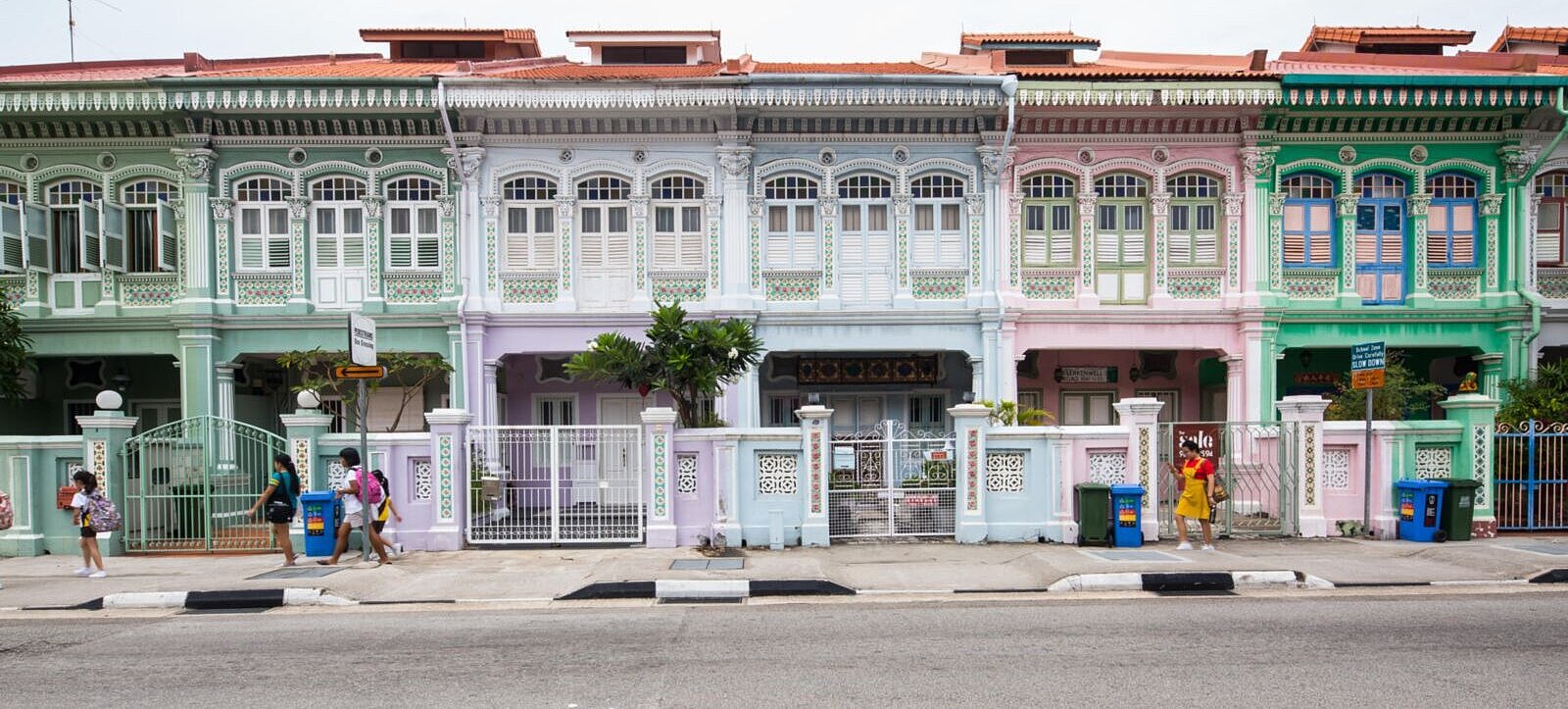
Singapore
Due to its limited land area, Singapore has to solve numerous challenges through innovation and technological progress that other countries overcome with the help of their natural resources or land area: imited drinking water resources, dependence on fossil fuel imports, high traffic volume in limited space, global warming due to dense development and sealing of land surfarces, or lack of residential space.
Accordingly, it is attractive for Singapore to use the space above its large wide roads by building „Innovation Bridges“ over them to create new areas: greened, inhabited, passable and suitable for collecting and transmitting rainwater or photovoltaic energy.
Singapore Innovation Bridges provide an opportunity to implement or use on a second level right through the country all the innovations in which Singapore is a pioneer, be it water management, autonomous driving, smart city solutions such as district cooling and many more. In addition, Singapore is strong in implementation and eager to implement - the best prerequisite for meeting the challenges of the future on green Innovation Bridges.
The Frankfurt Bridges will function like a large live-laboratory for all kind of innovations: regarding urban energy concepts, city water-management, autonomous driving and many more – turning Frankfurt into the innovation center of Europe

Singapore could play a similar role in East-Asia

Summary: Singapore can create solutions to many of the country's challenges with the help of innovation bridges across its motorways
Singapore faces the challenge of providing sufficient resources for its growing population and industry. At the same time, it will foreseeably suffer from the consequences of global climate change and is therefore paying particular attention to all aspects of sustainability and the environment in the further development of the country.
With the help of the Singapore Innovation Bridges, numerous complementary measures can be implemented:
1. Singapore gets hotter and hotter
In Singapore, average temperatures are rising more than in most other parts of the world due to climate change, as it is not only close to the equator, but also has a particularly dense population and thus widely sealed surfaces. The Singapore Innovation Bridges will create unsealed green space over sealed, dark, busy roads. The streets shaded in this way can no longer heat up during the day as before. This leads to an improvement of the small-scale urban climate in the affected areas of the city and thus to an upgrading of all properties along the course of the bridges.
2. Singapore needs more renewable energy
Currently, the main source of energy is imported gas. In order to become independent of this, Singapore needs, among other things, more large-scale photovoltaic plants – for which land is required. By using the infrastructure of its highways for photovoltaic systems, Singapore can generate around 3.2 TWh p.a.: On the one hand, photovoltaic energy can be generated in the form of „Energy-Bands“ along the highways; on the other hand, the Singapore Innovation Bridges could themselves carry photovoltaic modules and also collect energy from photovoltaic systems on roofs to the right and left of their course, in order to compensate for volatility by bundling or to bring the energy to storage locations. The prerequisite is a competence that Singapore is already successfully building up: energycontrolling for the smart cityof the future.
3. Singapore needswater
Singapore covers almost half of its annual water requirements (approx. 600 million m3 p.a.) until 2061 through imports from Malaysia. Independence from this is being sought through New Water (treated wastewater) as well as desalination of seawater and collection of rainwater in reservoirs. The Singapore Innovation Bridges could collect up to 13 millioncubicmetersofrainwater in large parts of the country and transport it to new deep reservoirs to be drilled, which are not as land-intensive as the water reservoirs. Over the past few decades, Singapore has developed the necessary expertise to use the subsurface for its infrastructure. Deep reservoirs with boreholes up to 100m deep could be implemented accordingly quickly and efficiently.
4. Singapore needshousing
Singapore is an attractive country for companies as well as for immigrants. The forecasted population growth is correspondingly strong, for which building space is needed. The area of the Singapore Innovation Bridges is 6.4 million square meters. On them, 7.5 millionsquaremetersofbuildingspace can be created, 6.5 million of which could become living space for more than 215,000 people. A prerequisite for the rapid and sustainable implementation of the Singapore Innovation Bridges is a competence in the production of prefabricated concrete elements with special shapes - such as Singapore has already been building up for years.
5. Singapore aimstoreducecartrafficwiththehelpofautonomousdrivingvehicles
While the Singapore Metro and busses provide excellent connectivity on many routes, and the number of vehicles in Singapore is limited by the government, there are areas with heavy car traffic, and there are still large parts of the country that are not connected, as well as routes that are difficult or impossible to travel by public transport. Singapore‘s Innovation Bridges over the highways could be used to quickly and comprehensively build an autonomous driving transport network that would significantly relieve the traffic flowing underneath. With a length of 250km, the bridges would carry traffic routes of over 500km.
6. Singapore has a strong awarenessofsustainability and wantstoreduceplasticwaste.
A microplastic-free, sustainable packaging system can be implemented on the Singapore Innovation Bridges, for consumer goods as well as for take-away food. In addition, massive greening of the bridges and their buildings can be created above the sealed motorway areas through microplastic-free underfloor irrigation. This green bridge-network can primarily serve as a stepping stone biotope for animals and plants and is in line with Singapore's goal of creating a "city in nature".
In Singapore, over six million square metres of green unsealed area can be created over sealed, darker trafficked area
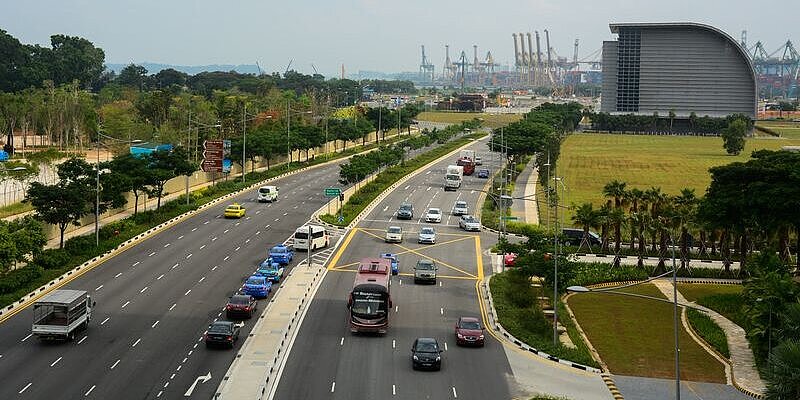


There are many wide roads that could be covered with green innovation bridges: In many cases it has to be decided to which extend the median strips of the roads, that are already planted with scrubs and trees, shoud be sacrificed for it

In the present concept, it is proposed to build mostly with recesses in the bridge-corpus for the trees, both on the roadside and on the median strip
Singapore has placed great emphasis on urban greenery for decades, true to its motto of being a "city in a garden". Accordingly, there is a beautiful old tree population along the roads that must be preserved. There are also plans to plant a further one million trees.
Leaving several-metre recesses/cutouts and holes on the body of the bridges especially for trees, reduces the number of possible bridge-buildings on one hand, but contributes overall to a much more pleasant cityscape on the other hand.
A wide variety of concrete forms are used for the recesses and holes in the bridges‘ concrete, which is now possible with the aid of so-called "3D Concrete Printing for Building and Construction" - a field in which the Singapore construction industry has built up considerable expertise in cooperation with the Nanyang Technological University.


Singapore's city centre is therefore not suitable for the construction of innovation bridges, as the cityscape is characterised by beautiful old trees and - despite wide streets in some places - an aesthetically pleasing streetscape.
However, despite the exclusion of the city centre, the bridge network will still make a positive and cooling contribution to the city climate.


(1) Singapore suffers from increasing heat - the government relies on massive greening of facades and the planting of one million trees as a countermeasure: unsealed bright or green bridge surfaces above dark sealed roads are an optimal complement to this strategy
Global warming due to global climate change is hitting Singapore particularly hard, as it is comparatively close to the equator and has had to intensively build on its limited land area for its continued economic growth. To counteract the rising heat in the city, Singapore is greening its facades and strictly controlling further sealing occuring through new construction projects. With green and bright innovation bridges over wide dark car streets, the negative albedo effect over six million square meters of car space is cancelled out: The Singapore Innovation Bridges not only provide a bright, green and thus climatically better surface, but they also cool -on a smaller local scale- through the shading beneath them.


Analysis of the impact of bridges over wide streets in Frankfurt city centre has shown: Without a shady bridge, PET rises to up to 37 degrees on a hot summer's day - with a bridge, on the other hand, it is only 27 to 29 degrees.
For the Frankfurt Innovation Bridges, the physiologically equivalent temperature (PET) was simulated for a heavily trafficked critical section in the city: When comparing this road section in ACTUAL (without bridges) and PLAN (with bridges), the model shows a significant cooling in the road area as soon as the bridges are built above it.
A comparable simulation is to be carried out for Singapore, which is made possible by the fact that a complete 3D model for the country is currently being created by the Singapore Land Authority, anyway.

Residents living near the Singapore Innovation Bridges should see at least a comparable, but probably even greater reduction in PET
(2) Singapore needs about 50 TWh of electricity per year – tendency increasing – and is therefore stringently looking for sources of renewable energy in order to become independent of fossil fuels
In Singapore, photovoltaic offers itself as the most important source of renewable energy: Therefore, the country even floats photovoltaic modules on its beautiful water reservoirs due to lack of space. Another major solution is the purchase of 7.5 TWh/a of solar power through an undersea cable from Australia.
However, there is one much more fragmented photovoltaic potential to be explored, and that is the use of surfaces on buildings or canopies on a large scale. The main challenge here is to control so much finely distributed volatile energy generation.



Photovoltaic modules can be installed on the surfaces of the Singapore Innovation Bridges, which can produce a total of 320 GWh - supplemented by „Energy-Bands“, which generate a further 750 GWh.
In all countries, Energy-Bands offer the possibility of quickly and easily setting up an infrastructure for generating energy (see below), and this is also the case in Singapore: With the help of Energy-Bands that run on poles along or across the roads, about 750 GWh can be generated in Singapore per year. However, due to the intensive tree planting along the roads in Singapore, the potential for Energy-Bands is limited to 750 GWh p.a., as trees create shadow and interruptions for Energy-Bands.
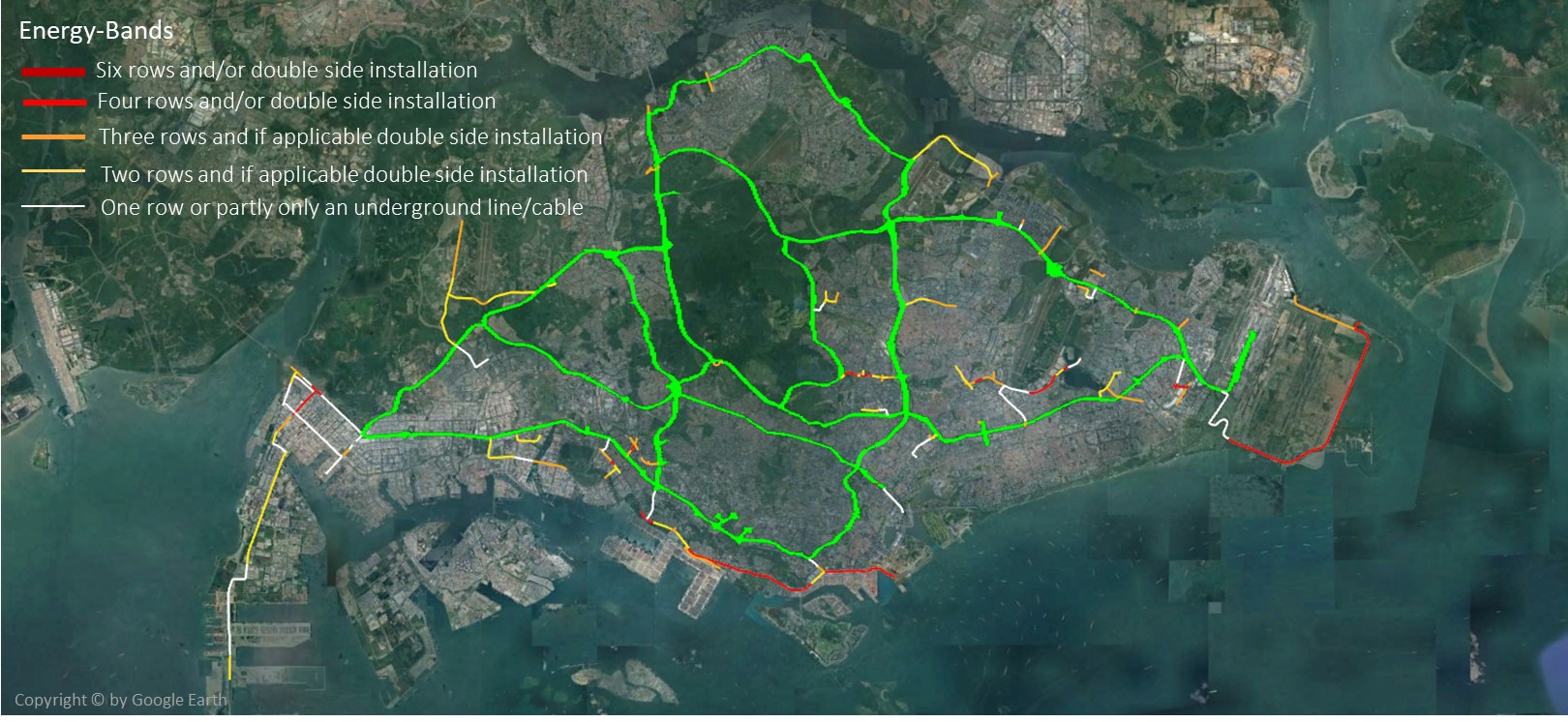
The potential for Energy-Bands in Singapore, while attractive, is low compared to other countries
Many roads in Singapore are wide, but still not suitable for Energy-Bands, which is primarily due to the fact that in Singapore roadsides and median road strips are often intensively planted with trees and large shrubs, so that the photovoltaic modules of the Energy-Bands are shaded. In some areas, this dense and valuable city greenery leaves no space for the masts of the Energy-Bands.
However, as an extension of the body of the Singapore Innovation Bridges, the Energy-Bands always have an additional function, which also has a positive effect in Singapore: just like the bridges collect photovoltaic energy generated to the right and left of their course, Energy-Bands can collect photovoltaically generated electricity from roof surfaces or canopies along their course and forward it to consumers or storage locations.
Energy-Bands (like the bridge corpus) are an "electricity collection network" for scattered and volatile photovoltaic electricity generated by the areas to the right and left along their course.



On thousands of roofs and canopies along the green Singapore Innovation Bridges and their „Energy-Band extensions", a further estimated 2.1 TWh/a of photovoltaic electricity can be produced
Distributed and volatile power-generation is a challenge for utilities around the world, since the conventional energy infrastructure is designed for centralized generation and distribution of power everywhere. Singapore could generate vast amounts of electricity photovoltaically on thousands of rooftops and canopies of parking lots or walkways - but the current utility grid is not designed for such volatility, nor does it have the appropriate control mechanisms.
With the Singapore Innovation Bridges and the Energy-Bands as carriers of a completely new network, the volatile energy can be collected and distributed or routed to temporary intermediate storage facilities. An appropriate control system must be developed for this purpose, which can be used to connect continously all areas in Singapore that can be used for photovoltaic, throughout the country. Their additional generation potential is likely to be more than 10 TWh/a in total.

For all areas along the Singapore Innovation Bridges and Energy-Bands, it is necessary to check which type of PV installation is suitable for them (A) Roofs on high-rise buildings
In high-rise buildings, which make up a large part of the building stock in Singapore, the ratio of roof area to building area is already very unfavorable. In Singapore, this is compounded by the fact that the roofs are occupied by satellite dishes, water tanks, outdoor air conditioning units and other equipment. In addition, walkways around the PV-modules must be maintained on the roofs, which also take up space.
Nevertheless, all high-rise residential buildings along the Singapore Innovation Bridges should be considered because of their uncomplicated implementation potential - since in most cases they are public housing properties to which the Housing and Development Board (HDB) has more direct access - unlike properties that are entirely privately owned.

PV systems that make optimal use of the space on the roofs can already be found for almost all typical roof shapes in Singapore. So far, however, these are special solutions that are not yet available as standardized subsidy packages from the government.
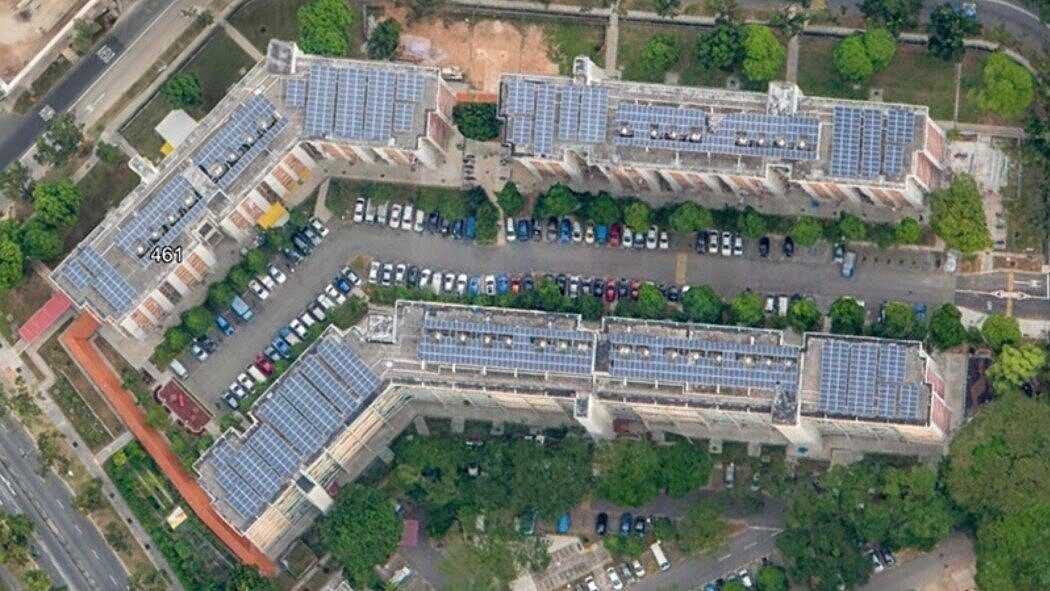

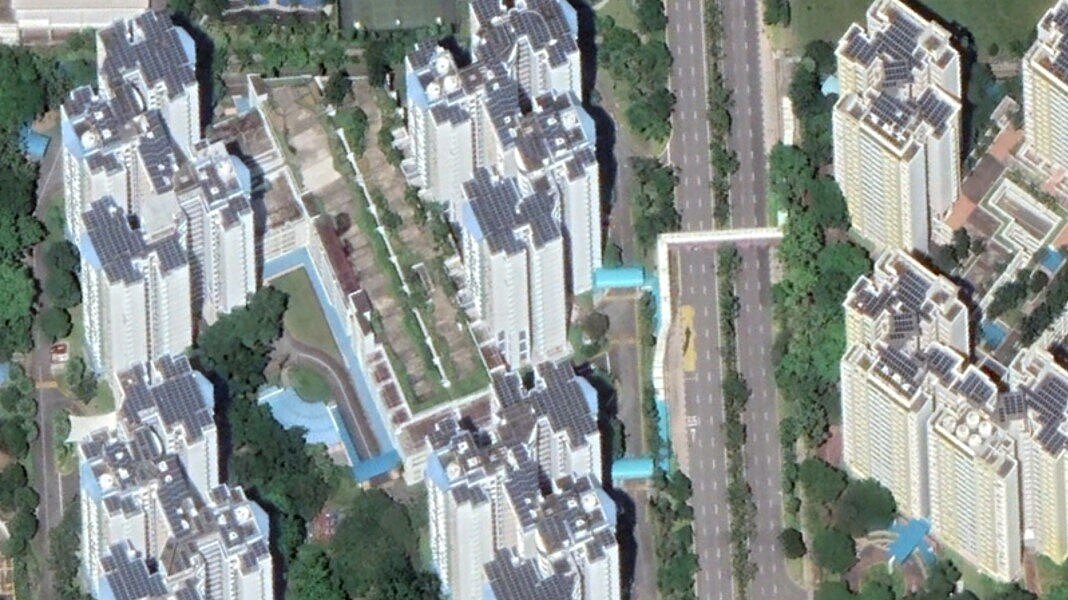
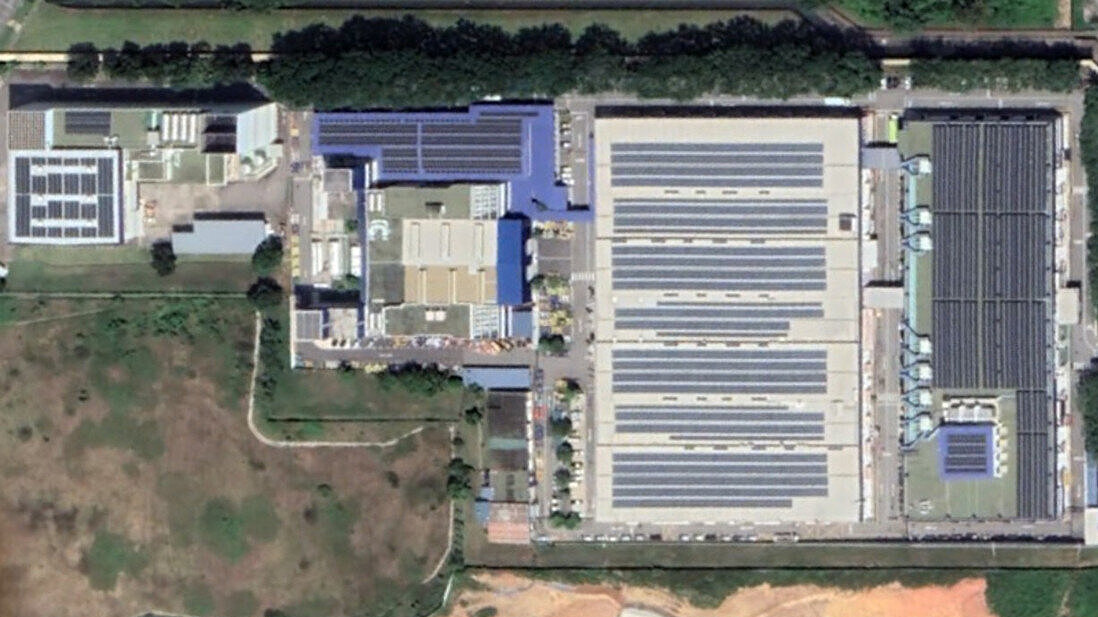
A comprehensive photovoltaic cadastre should be created for Singapore. In the photovoltaic cadastre, each building along the Singapore Innovation Bridges and Energy-Bands can be recorded as to whether or for which type of PV modules it is suitable.
Many roofs present special challenges: Some are so full of equipment so that installing PV modules becomes difficult. Others have particular colors (e.g. blue) or shapes (e.g. barrel shape) that should be replicated with PV modules. And still others have roof surfaces that are interrupted by ridges, tiny windows or air shafts around which the PV modules have to be elaborately installed.


For all areas along the Singapore Innovation Bridges and Energy-Bands, it is necessary to check which type of PV installation is suitable for them (B) Tiled roofs
Some districts in Singapore have a building landscape whose roofs are covered with red tiles.
Here, it does not make sense for the cityscape to install black photovoltaic modules. An alternative in the future could be red-colored PV modules in tile form. While red-coloured PV modules already exist, no red PV modules have yet been developed that also have the right tile shape. Only black PV modules with a convincing tile shape are already on the market.
However, adequate rooftop PV for districts with special roofs are under development and are expected to come on the market in the near future. The potential of these districts should then be added to the generation quantities calculated here.



For all areas along the Singapore Innovation Bridges and Energy-Bands, it is necessary to check which type of PV installation is suitable for them (C) Parking roofs
On many buildings in Singapore, one still finds parking roofs that are more or less intensively used.
The areas there can be provided with photovoltaic canopies (whereby the supports for the canopies must not be located in the driveways).
While the surface of the canopies generates photovoltaic electricity, the canopy also has a shading and thus cooling effect for the cars parked underneath.
However, for adequate shading as well as for stable statics, the construction (unlike ground-covering photovoltaics) must extend to the edge of the roof.

For all areas along the Singapore Innovation Bridges and Energy-Bands, it is necessary to check which type of PV installation is suitable for them (D) Parking spaces
Singapore aims to reduce the number of vehicles, and thus parking spaces, by expanding public transport and promoting taxis and Uber - but there are still large parking lots for „PV harvest“.
However, because many parking lots have been planted with trees, canopies will often be fragmented. Nevertheless, even a small-scale PV canopy will make sense at the latest when a large proportion of the vehicles in Singapore will be e-cars and the electricity for these will be produced on site and can also be fed directly into vehicles parked there.
Whether special designs are worthwhile for recesses in trees or not, must be examined on a case-by-case basis, as must the question of whether PV canopies are worthwhile for parking lots on the rather shadowed north side of buildings.

Car parks with dense tree cover should not receive photovoltaic roofs
There is enough space for photovoltaic installations in Singapore, so that no trees have to fall victim to the production of renewable energy.

In order to protect trees and still generate as much energy as possible directly at the parking lot, in special cases the traffic routes on the parking lot can be covered on top or even instead of the parked cars
The prerequisite here, however, is that access routes for the fire brigades are maintained. Furthermore, covered traffic routes can only be driven on by vehicles that have the appropriate height - because if it is a pure car parking area, the roofing there only has a certain height, and this piece of traffic route can then no longer be driven on by trucks.

For all areas along the Singapore Innovation Bridges and Energy-Bands, it is necessary to check which type of PV installation is suitable for them (E) Walkway canopies
A walk can sometimes get very hot in Singapore - so there are already many walkways and waiting areas that are covered.
PV modules can also be installed on these canopies, provided they are located near the Singapore Innovation Bridges or the Energy-Bands, so that their volatile energy can thus be fed into a grid optimised for this purpose.
Other paths can also be provided with canopies that support PV modules, especially if there are properties nearby whose roofs are also covered with PV modules and which therefore have a line to the Singapore "Innovation Bridge Backbone„, anyway.



If Singapore opts for widespread installation of PV modules, however, white PV modules should also be used specifically, as otherwise significant local heating could result from the numerous black surfaces
Photovoltaic is the cheapest and easiest form of renewable energy to install. It has only one disadvantage: It is most efficient when it is black, but then it unfortunately also heats up the most. If you plan large-scale PV solar parks for an entire region, you always run the risk of regional warming.
Accordingly, roofs in Singapore that are already bright white or light today should be covered with white PV instead of black PV. True, white PV has only 11%-13% efficiency, while black PV has 23%-25%. But The total amount in Singapore along the innovation bridges and on them is 1.35 million square meters of area for which bright PV is recommended. This generates about 290 GWh of electricity - a considerable amount, contributing 7.25 TWh/a of electricity over a 25-year lifetime.
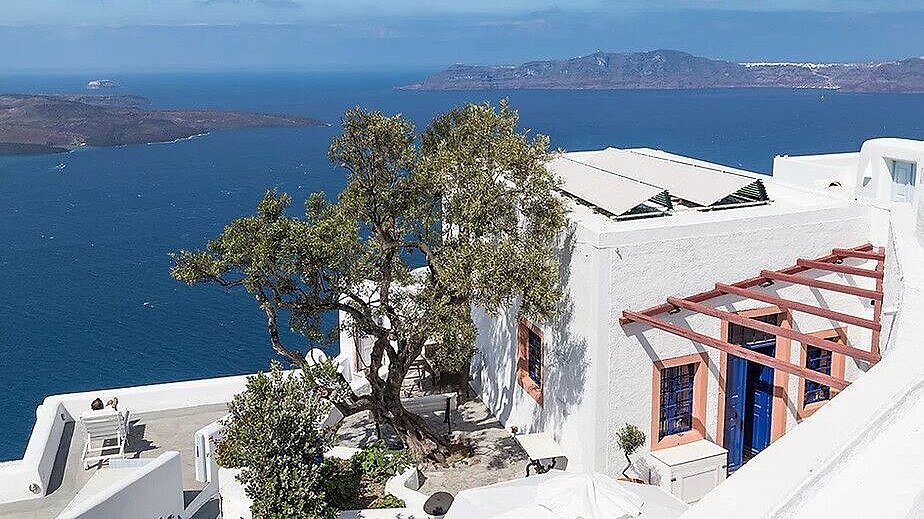

Over 2 TWh/a can be generated on rooftops and car park canopies along innovation bridges in Singapore
In the present analysis, only roofs that do not have to fulfil an aesthetically relevant task have been taken into account. Accordingly, no single-family or multi-family houses with sloping roof shapes have been included in the calculation; red tile roofs and pretty colourful roofs have also not been included, as aesthetics play an important role here and should not be destroyed by PV modules.
In the future, however, these roofs could also have PV potential as soon as PV modules that are visually adapted in terms of colour and shape are developed.
Furthermore, mostly only roofs and parking lot canopies with a minimum size of 200sqm were considered. A more detailed inventory would also include smaller roofs and canopies with an estimated additional 20% PV generation area.
Potential path canopies are not yet included in the present analysis. This must be done with detailed knowledge of the respective localities, the buildings adjacent to the paths and the paths use. Here, too, up to 20% PV generation area could be added.
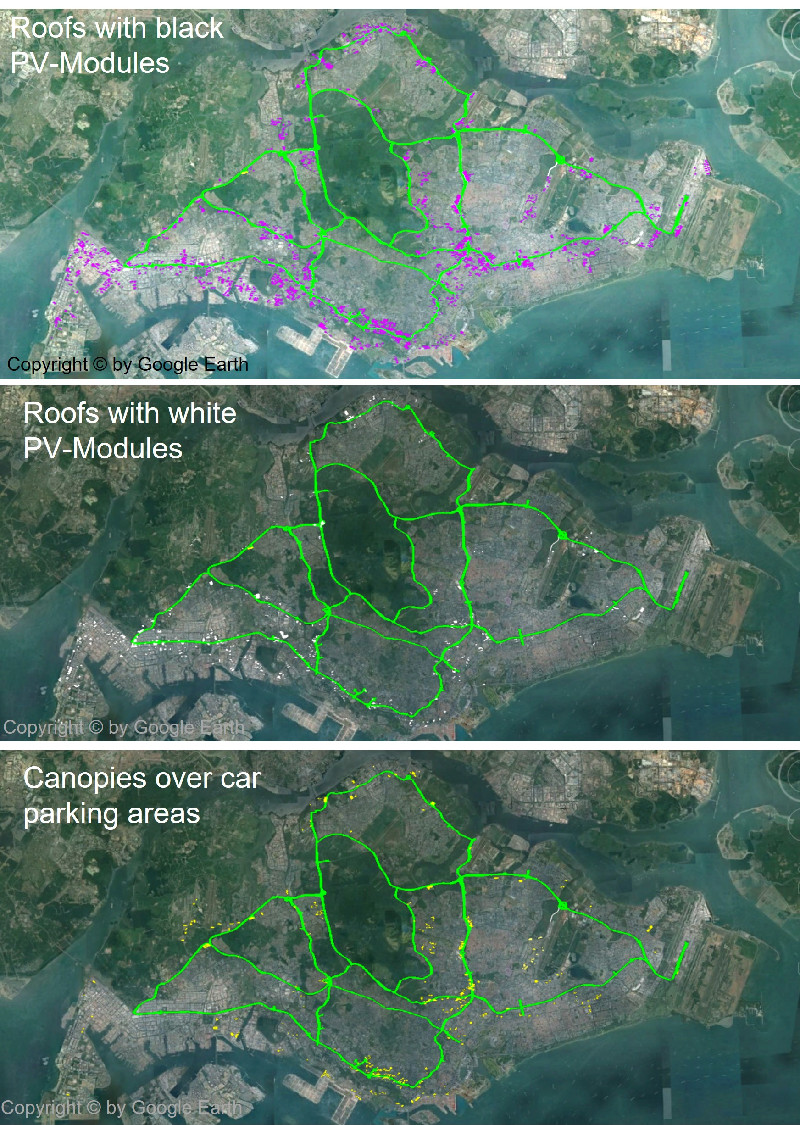
In order to enable a systematic and comprehensive roof utilization along the Singapore Innovation Bridges and Energy-Bands, Singapore needs to create a photovoltaic cadastre in which all roofs and roofing possibilities are recorded and evaluated
In the photovoltaic cadastre, roofs and parking lots are to be analyzed and evaluated along various dimensions:
Roofs
- Aesthetics and function: Is it a flat roof (PV remains invisible) or a beautiful roof over housing? Has it a religious function? etc.
- Location: distance to the nearest PV grid feed-in point at the Singapore Innovation Bridges or Energy-Bands
- Size and shape: Can PV be installed using a standard "modular" process and modules?
- Construction: Can the roof bear the load of PV systems? If necessary, check thin-film and lightweight modules as an alternative
- Age: Is it worthwhile to install a PV system or will a roof renovation be necessary in a few years?
Parking
- Size and frequency: Is PV roofing worthwhile? (For intensive use without shading often effective from 2 cars).
- Trees between canopies: number, size and expected size of trees between a canopy in the parking lot: Are there standardized special canopies with recesses/cutouts for the existing trees which must not be sacrificed for PV-modules?
If individual building owners set out privately one by one to explore photovoltaic potential on their rooftops, to select the appropriate technology and type of PV, and to screen the market for it, then it is likely to take a very long time for Singapore to exploit its PV potential along the innovation bridges and Energy-Bands. Therefore, Singapore should commission the development of suitable modular PV units from the government side and incentivize or subsidize the installation of PV on all rooftops.
Singapore can exploit its PV potential most quickly if a modular "construction kit" for PV systems on roofs and parking lots is developed with government support and if its use is financially subsidized
Control systems for balancing and storing the volatile energy "collected" along the Singapore Innovation Bridges and Energy-Bands are a challenge - but Singapore is on its way to becoming a "smart city„, anyway
PV modules can be installed on both sides of the body of the Singapore Innovation Bridges as well as on the roofs of the bridge buildings, so that the entire bridge world can generate its own electricity on a scale of around 320 GWh - and supply surpluses to the rest of the city. The Energy-Bands that branch off from the Singapore Innovation Bridges generate a further 0.75 TWh/a of electricity.
In addition, there are the large amounts of electricity that are collected from the areas to the left and right of the Singapore Innovation Bridges and the Energy-Bands, and are forwarded to various users once they reach a surplus at the place where they are generated: for example, from car park roofs where no vehicle is currently parked and charged with electricity, or from roofs of industrial companies where there is no business on Sundays.
Singapore will rise to this challenge, because it is considered the number one in the world on the way to becoming a smart city: For example, Singapore has already developed a complete district cooling system, the "Punggol Smart Town", and the government has set up numerous other "Strategic National Projects" to optimize the entire infrastructure in this way: Operational controlling technology for a PV grid fits perfectly into the competence profile that the city has built up, already.
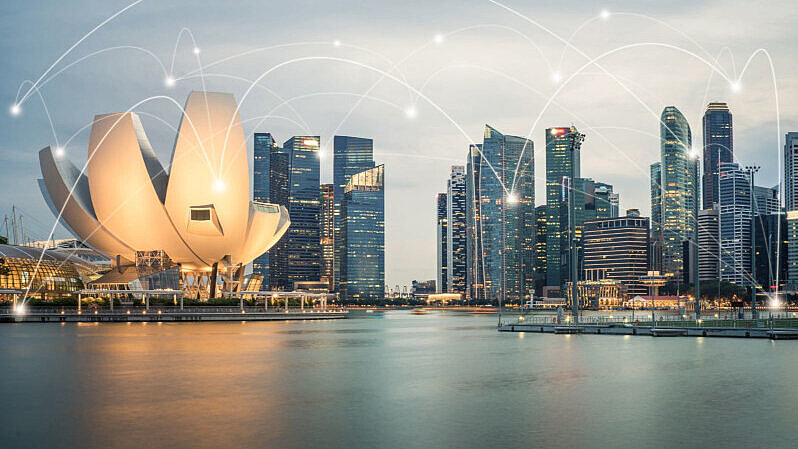

The location of the PV modules must not be too scattered: All areas suitable for photovoltaics along the bridges must be recorded in the PV cadastre
It must be defined for each bridge section how far away a property may be from the bridge line in order to still connect the photovoltaically activated area to the main power line in the bridge body with justifiable effort and an attractive return on investment. In this context, not only the size and location of the respective photovoltaic area in connection with the pure distance from the body of the Singapore Innovation Bridges are relevant, but also the degree of its "networking" to the bridges.
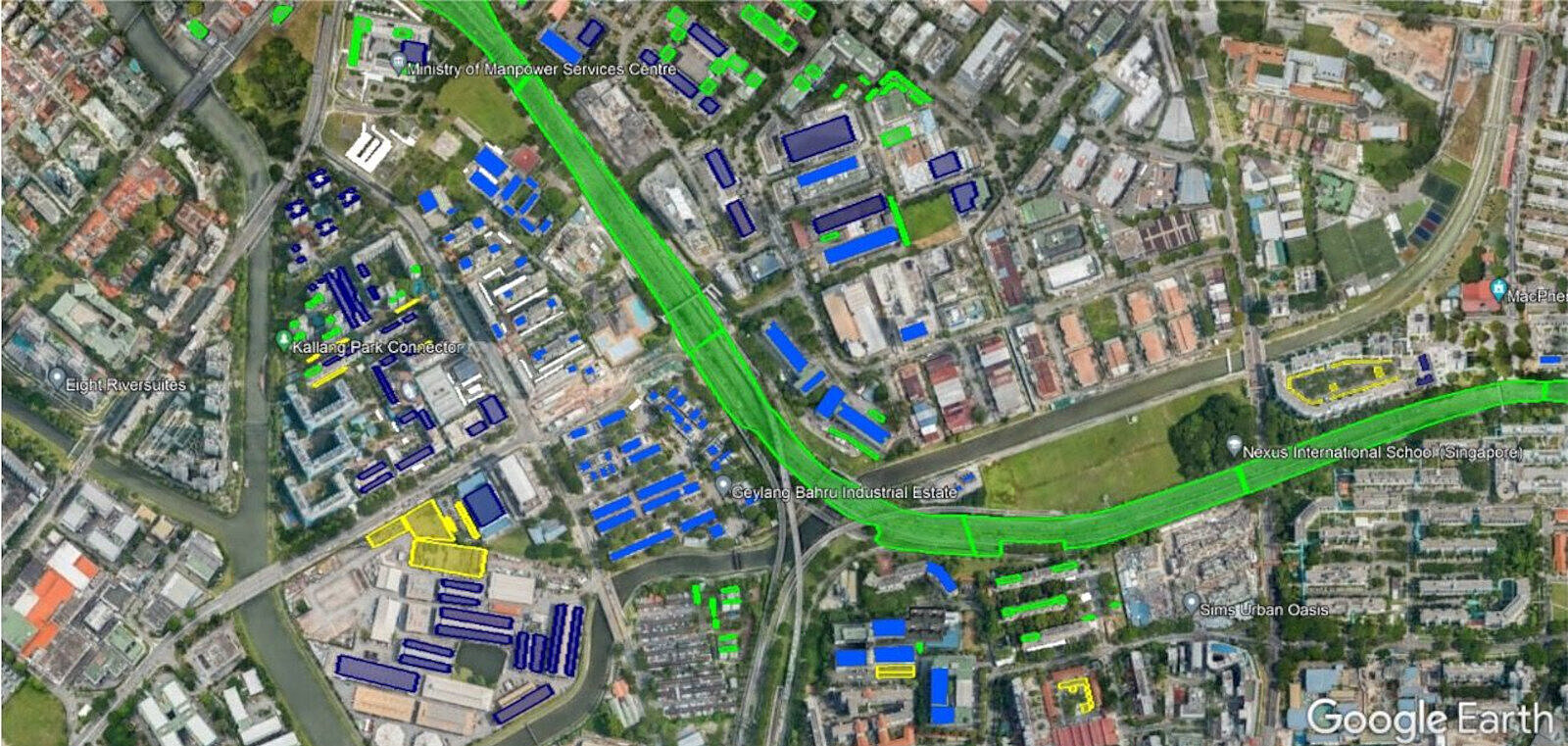
Photovoltaic areas further away from the body of the Singapore Innovation Bridges are only of interest if, in combination („networking“) with other areas, they economically justify a supply line to the "bridge electricity backbone"
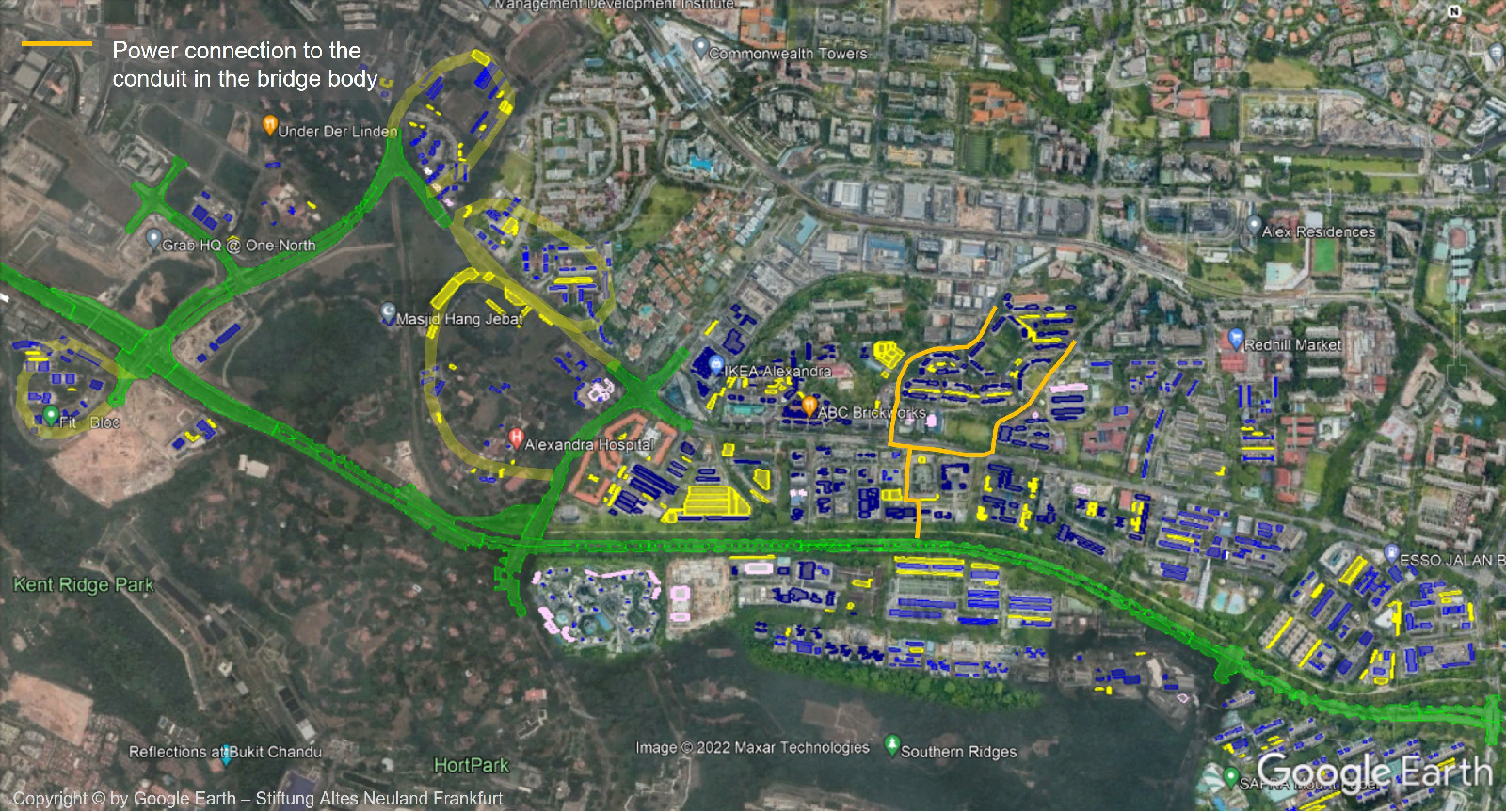
Summary: The Singapore Innovation Bridges can collect over 2 TWh/a from areas right and left, and produce 320 GWh/a with their own bridge areas - another 750 GWh are added by the Energy-Bands
Of the approximately 3.2 TWh/a. collected with the help of the Singapore Innovation Bridges and the Energy-Bands, about 0.3 TWh/a could be transported to underground hydrogen storage facilities, which would cover an area of approximately half a square kilometre.

Singapore currently consumes around 50 TWh of electricity per year: The rather fragmented activation of 3.2 TWh/a generation potential on roof tops with the help of Singapore Innovation Bridges and Energy-Bands can make an important contribution to the electricity supply of the country
If smaller areas than in the analysis presented here are also taken into account when compiling the photovoltaic cadastre, the total potential along the bridges and Energy-Bands is estimated to be around 5 TWh/a.

Singapur ist ein wachsender „Data-Center-Knotenpunkt in Südostasien. Die Versorgung dieses Bereiches mit Strom wird eine immer größere Herausforderung: Energiebänder und Brücken können als Strom- und Datenleitung Abhilfe schaffen, zumal sie an den größten Data-Centern vorbeilaufen

(3) Singapore needs water: The country consumes around 660 million cubic metres of water per year. Although rainfall amounts to 1.7 billion cubic metres per year, only 10% of this can currently be collected or used
Singapore suffers from water shortages for its growing population and industry, and currently still has to import almost half of its water requirements (which amount to 600 million m3 p.a.) from Malaysia. Of the 1.7 billion m3 of rainfall that falls on Singapore annually, only about 160 millioncubicmetres is currently captured or stored in Singapore's 17 water reservoirs, the rest seeps away, evaporates or ends up in the sea. In order to store even more rainwater in reservoirs, more freshwater areas would have to be created, which will be difficult given the shortage of land in Singapore - even though the current water reservoirs are all beautifully integrated into the landscape and used as recreational areas.


The Singapore bridges can collect 7 million cubic metres of water and transport it to storage facilities - which, because of the lack of space, should be deep rather than wide
As with many other infrastructure elements, Singapore can turn to underground space for water storage: About 15 million m3 of rainwater falls on Singapore's bridges, and about half can be directed from the bridges to cylindrical ground storage tanks, which take up space in depth rather than in area.
With a depth of 100 meters and a diameter of only 10 meters, 225 reservoirs would be sufficient for the approximately 7 million cubic meters of water that are delivered by the Bridges. The locations for these deep reservoirs can be selected along the entire bridge route, taking into account the respective to the geological conditions.
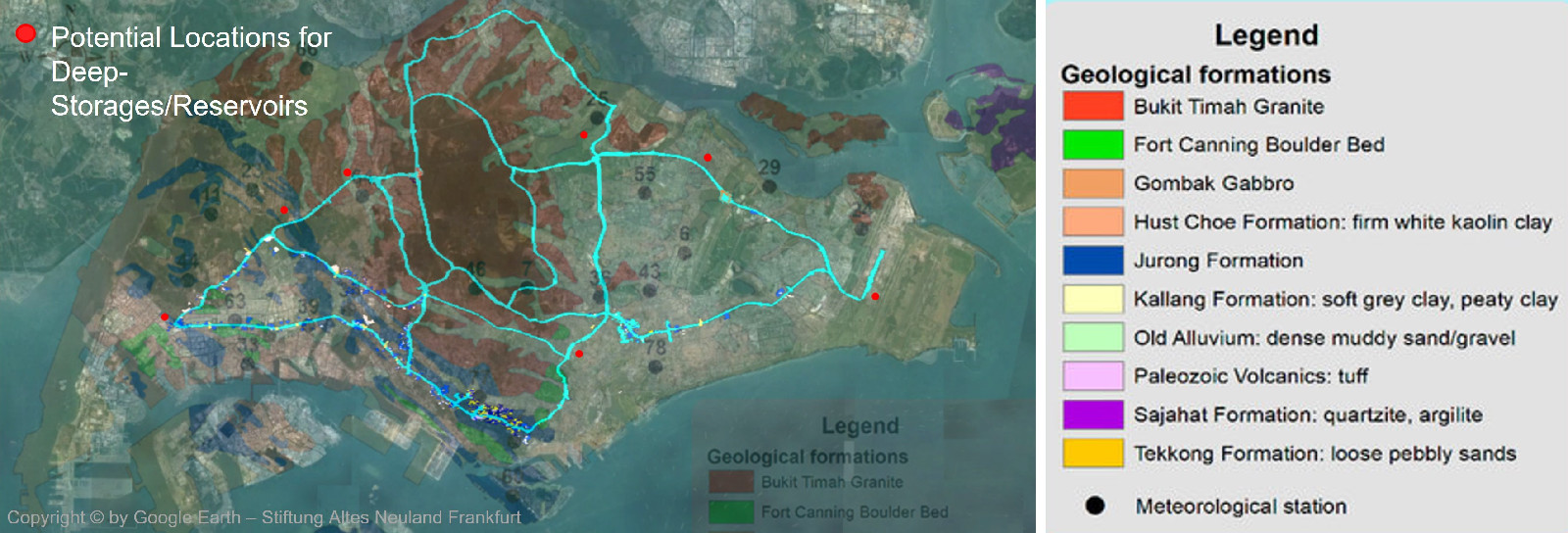
Singapore has significant expertise in burying infrastructure deep underground: it has already relegated its water management to subterranean depths with a sewerage system up to 40 metres deep



If the bridges also collect rainwater from properties to the right and left of their course, they can transport an estimated further 6 million m3 of water p.a. to storage locations - with their own 7 million m3 this would be a total of 13 million m3
The Singapore bridges cross parts of the country that are further away from the main canals and reservoirs. Some of the properties to the right and left of these have large sealed areas, large roofs or parking lots that will be covered with photovoltaic canopies. The bridges can help collect stormwater from these areas. The prerequisite would be that for larger properties with 1000sqm of rainwater area and more, a cistern bylaw is enacted that requires a cistern to be installed on one's own property that collects the rain as a buffer during rainfall events and then pumps it on to the bridges that transport it to the deep storage tanks. Their number (or size) would have to be almost doubled for this (i.e. 450 instead of 225 storage tanks).

More than half of Singapore's water is used by industry - the bridges could transport more rainwater directly to deep reservoirs in regions populated by industry
Singapore’s industry is receiving more and more "New Water" (treated wastewater), but the demand is huge and growing.
Most of the water used is drinking water, even though most industrial processes do not require such a high degree of purity.
Singapore bridges can reach almost anywhere - accordingly, they can also specifically transport the rainwater they collect to deep storage tanks near industrial areas: Thus, the rainwater then only requires rough cleaning and does not have to be 100% drinking water quality.
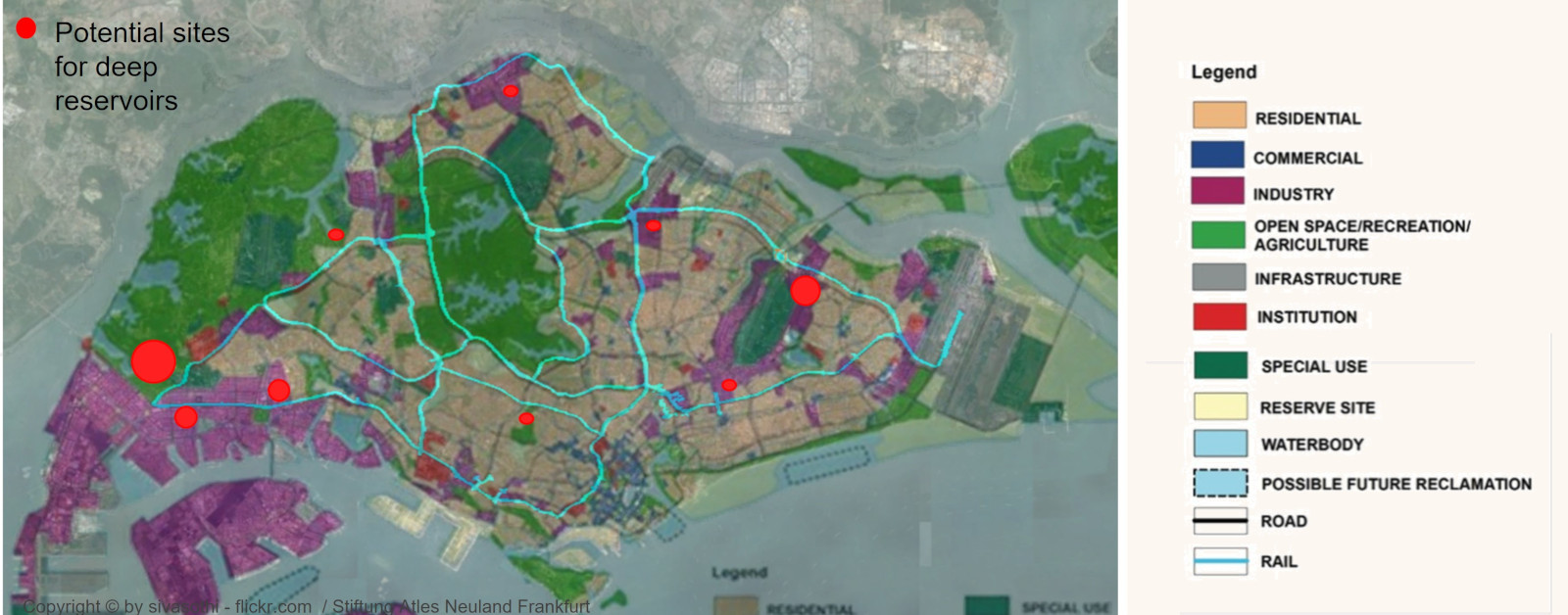
(4) Singapore needs housing: a growing economy, increasing number of single households and greater living space requirements per person are leading to an ever-increasing demand for housing – on the Singapore Innovation Bridges housing can be created for over 215,000 people
Singapore has the problem that its land area is scarce, and it would like to avoid further sealing in order not to exacerbate the trend of rising temperatures in the city. So far, the option of turning to the sea has been used, but even this option has limits, especially since for each building land must first be extracted at great expense.
The bridges offer a new alternative: 6 million square meters of unsealed green space can be created above Singapore‘s roads. With regard to the tree population on the middle road-stripes, „bridge building land“ will not be created in all sections, as the recesses/cutouts in the bridge corpus for the trees take up a comparatively large amount of space. But even if only 25% of the bridge surface area is built on with buildings that have an average of 5 full floors, there will already be over 7.5 million square meters ofbridge building space. If only 6.5 million of that is used for housing (and the rest for education, culture, shops, restaurants, etc.), over 215,000 people can live there.
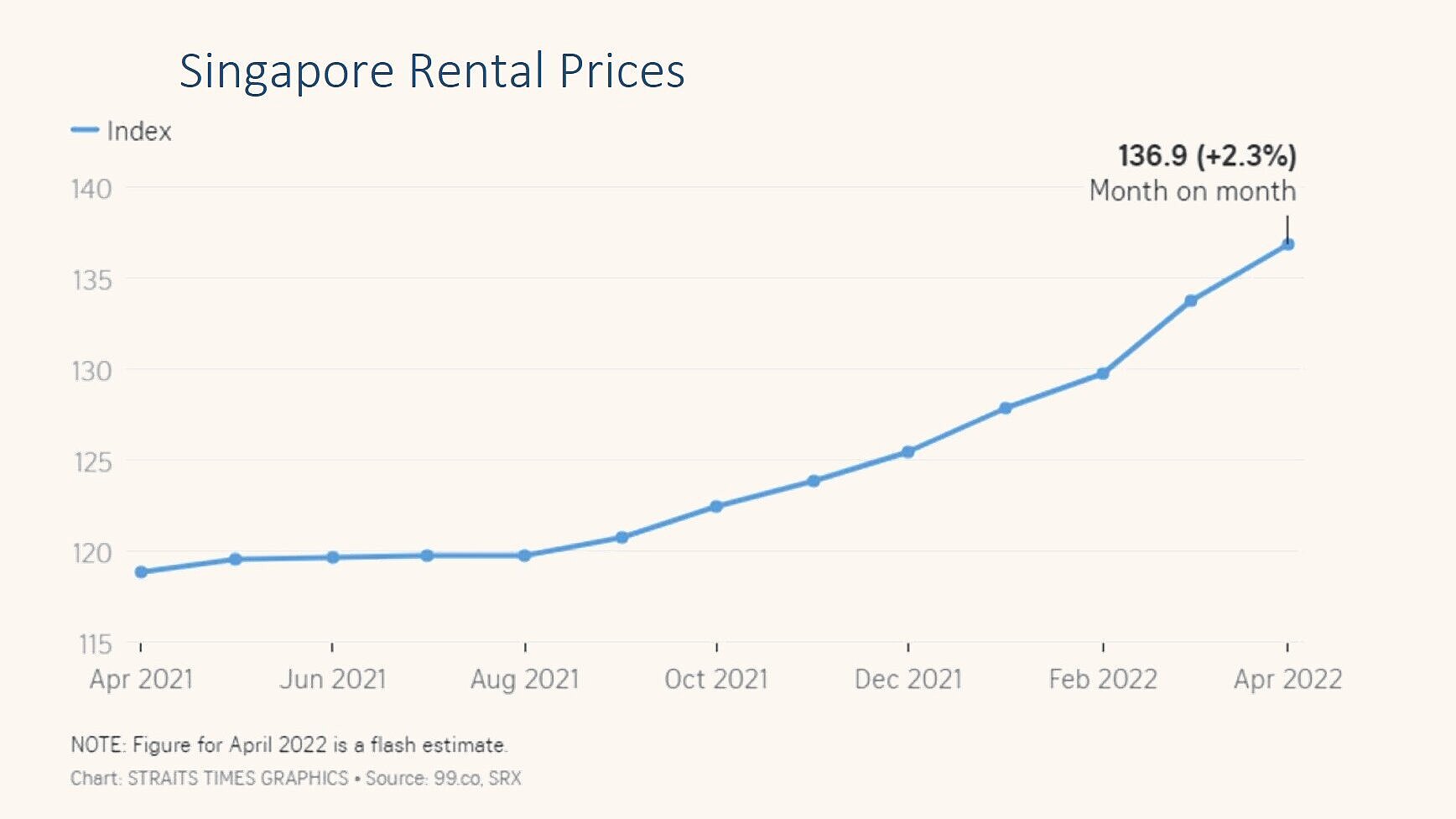
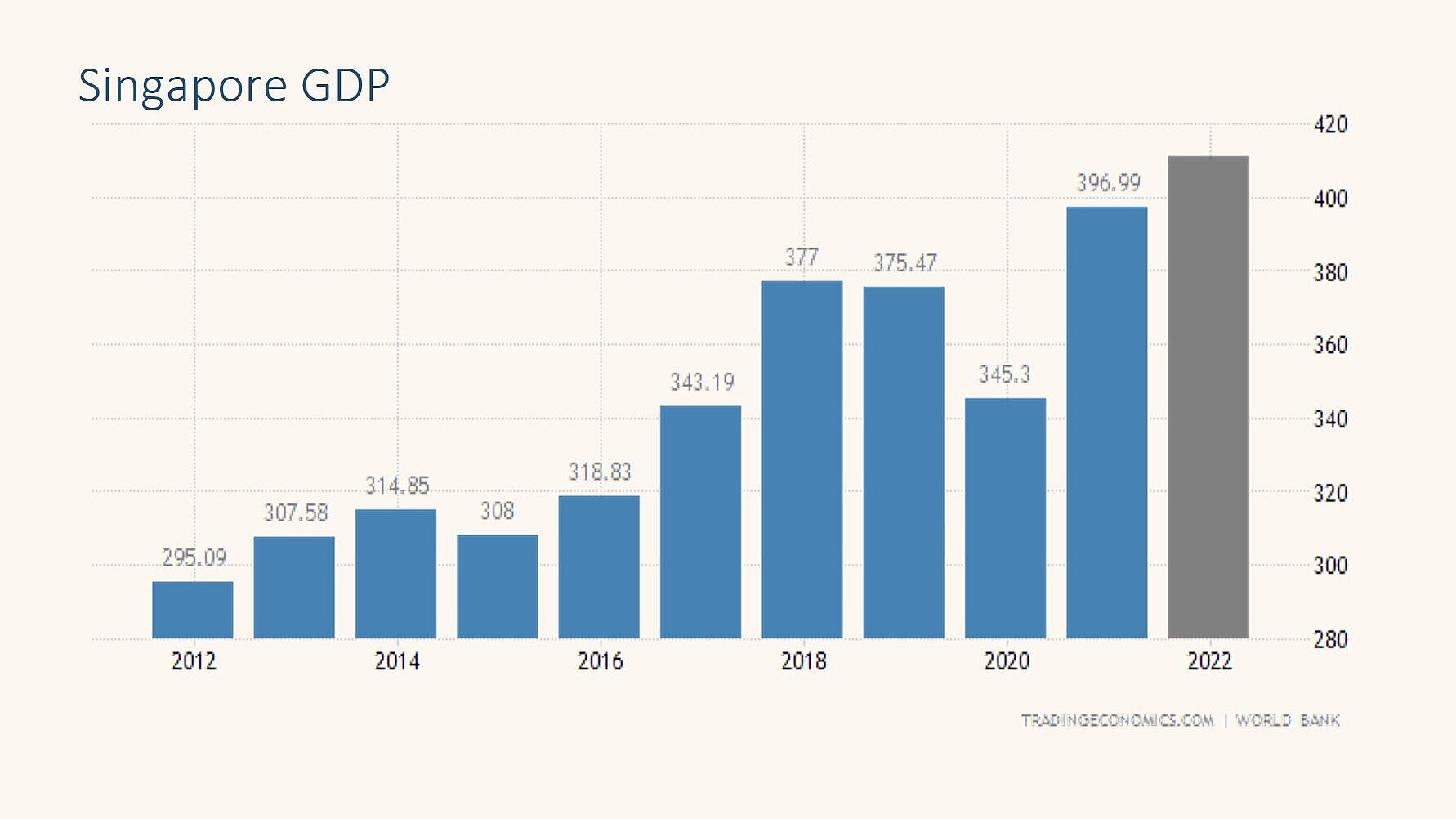
All architectural styles of Singapore should be represented on the bridges: modern as well as old architecture
Singapore has impressive modern architecture - however, as everywhere else, it is primarily the museums, hotels or public buildings that are spectacular, and rarely the residential constructions.



Modern apartment buildings and blocks of flats in Singapore are, as in all parts of the world, mostly rather uniform - but there are also some architecturally successful exceptions.
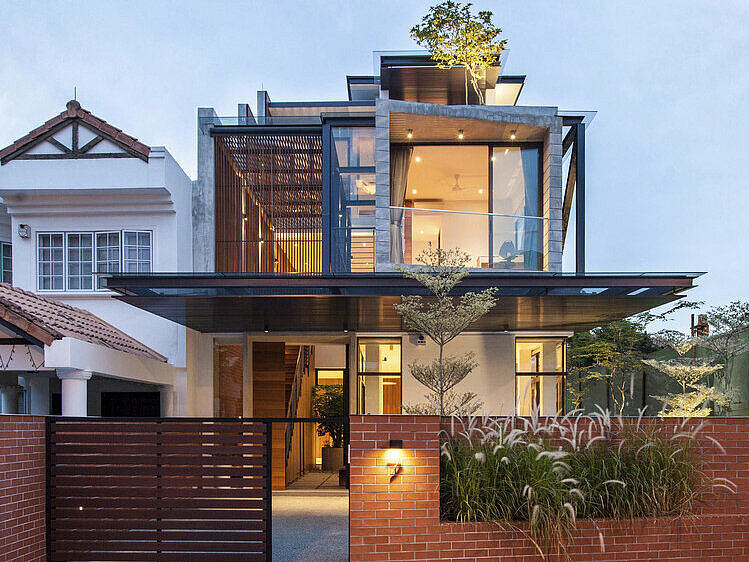


Modern architecture can be particularly effective on bridge sites adjacent to wooded areas, where bridge buildings can be up to six or seven storeys high
An example: Approximately 100,000 square feet of building space can be developed on this bridge site at Upper Seletar Reservoir, with building heights ranging from 3 to 7 stories. The bridge construction is limited to the road and to those parts of the green land where only few trees are scattered on otherwise plain lawns.

However, many people in Singapore also have a strong sense for their traditional architecture - accordingly, it makes sense to also rely on Singapore‘s beautiful architectural heritage in large parts of the Bridges
The so-called "shophouses" are particularly popular in Singapore - among Singaporeans as well as expatriates, tourists and foreign investors. The price per square metre for such pretty little houses is currently 25,000 to 35,000 euros per square metre for well-maintained examples.
Traditionally, a business ("shop") is located on the ground floor and the operators live above it. Converted into residential buildings, both floors can contain living spaces, and the narrow seating area in front of the ground floor is often used as a terrace.
If Shophouses are built in the traditional way, the results are highly sustainable buildings, both because of the materials used in the region and because of clever ventilation systems.


Shophouses are sustainable buildings by modern standards: Natural materials are used in their construction, and the traditional architecture is designed to ventilate and cool the building.
The roofs are made of clay tiles, the doors and window frames as well as shutters are made of wood, the building material of the walls are extremely durable bricks, and the beams are also made of wood.
There are ventilation shafts and ducts inside the houses and also sometimes on the outer facade hidden in the decorations, e.g. in the window parapets. The air circulation towards small courtyards is also so sophisticated that the buildings experience a pleasant light cooling. This sustainable construction method of the Shophouses reduces the use of air conditioning and meets state-of-the-art sustainability standards.

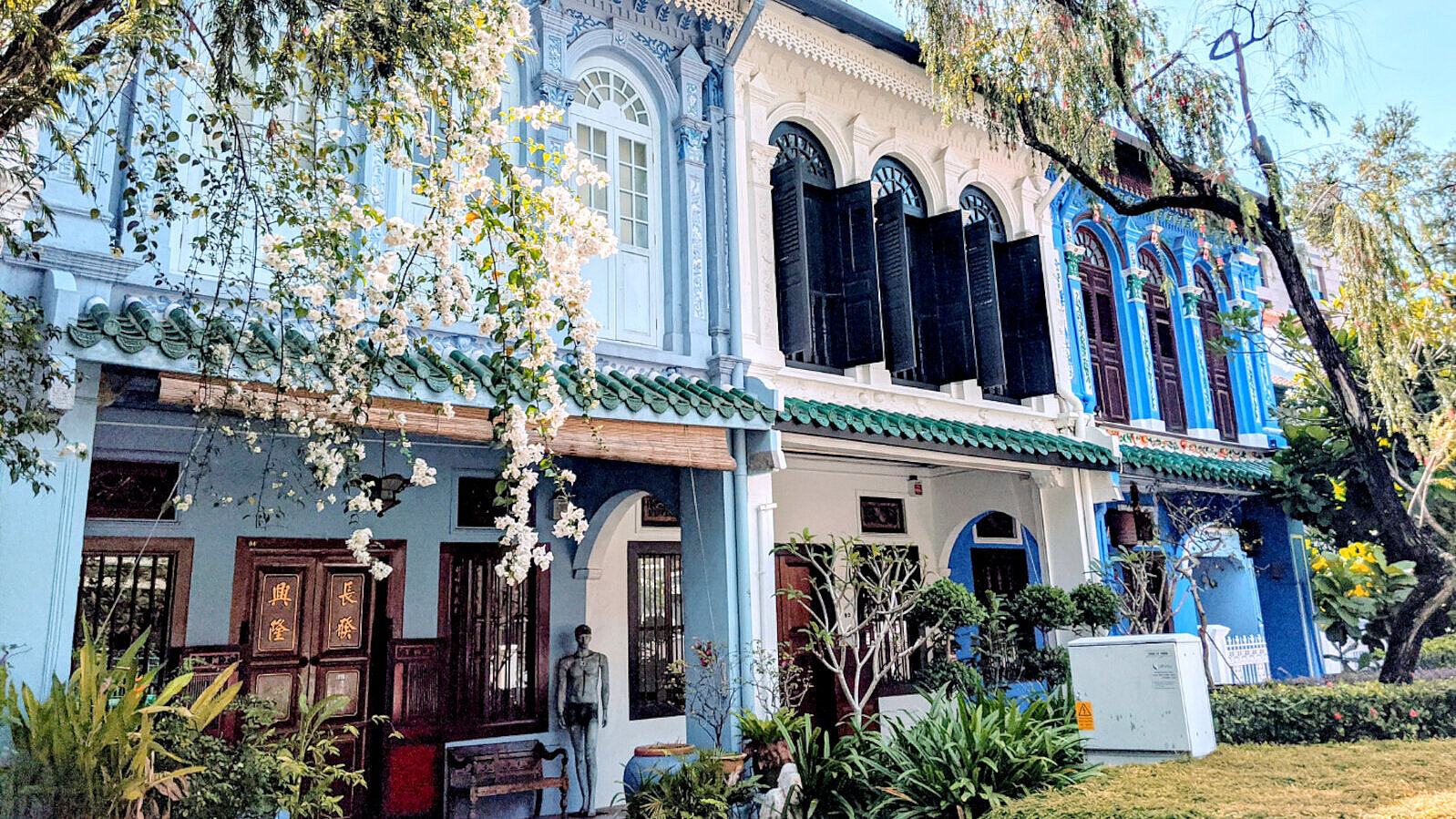
The special thing about the Shophouses is the mixture of styles from different regions: Chinese wall decorations can be found next to Ionic-looking half-columns, and Venetian Oriental roof friezes above Corinthian-inspired pilasters.
The internationality and peaceful coexistence of the most diverse cultures in Singapore finds its architectural expression in the Shophouses.


The Shophouse construction has Singapore in common with Malaysia, where similar eclectically designed houses can be found especially in George Town Penang
The resemblance is so great that only connoisseurs can distinguish which buildings are Singaporean and which are Malaysian - which is not surprising, since almost one seventh of the population in Singapore is of Malay descent.
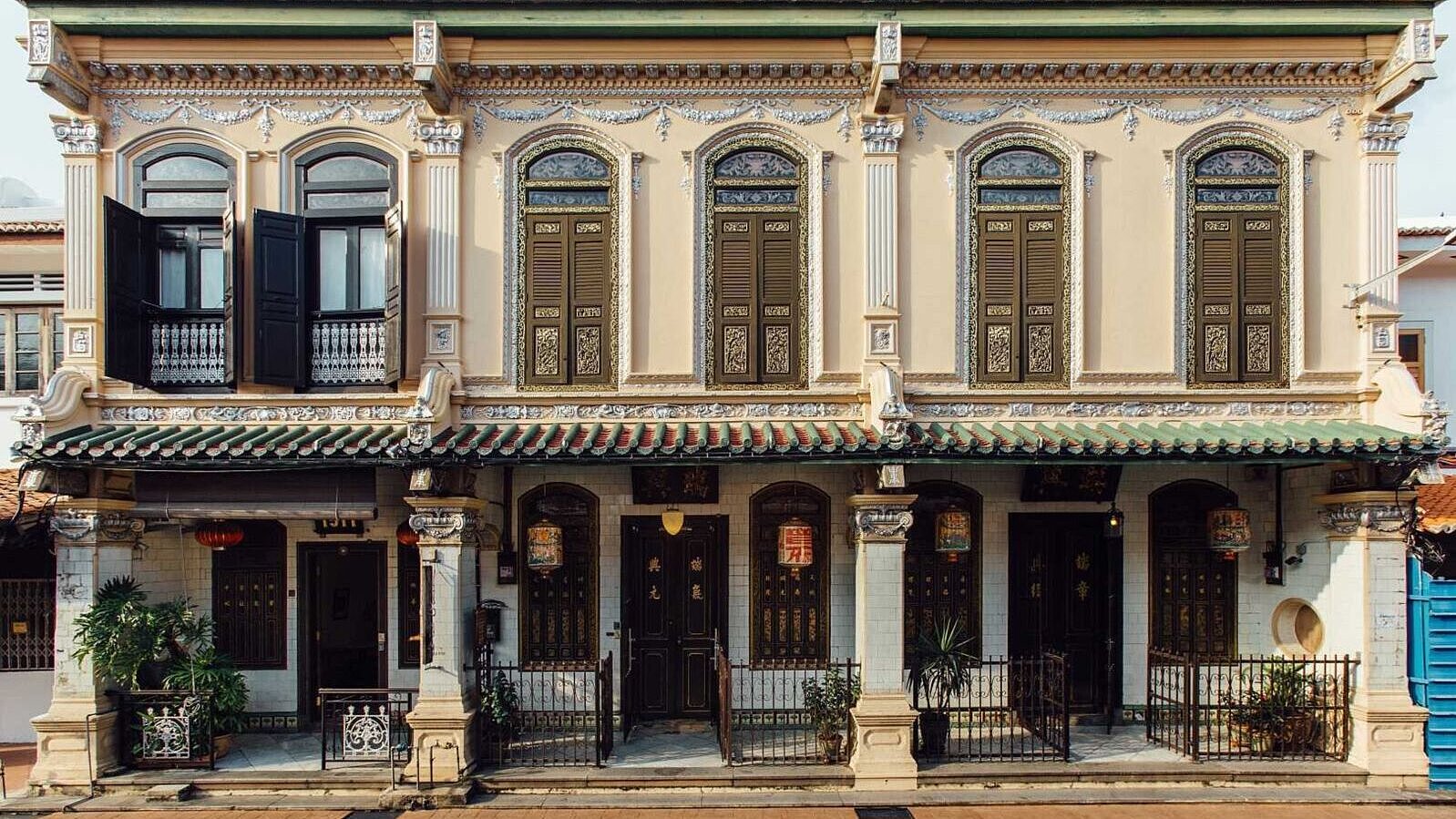




Shophouses in Singapore, however, often have bolder colours - a trend that is perhaps due to the stronger Indian influence in Singapore


For the Shophouses in Little India the prices in Singapore are between 16,000 and 20,000 euros per square metre
Like other Singaporean Shophouses, the houses in Little India are precious cultural assets that are a unique part of Singapore's architectural heritage.





High-quality traditional Shophouses can be built, for example, on the narrower bridge sections close to the city centre - centrally located but still in the countryside
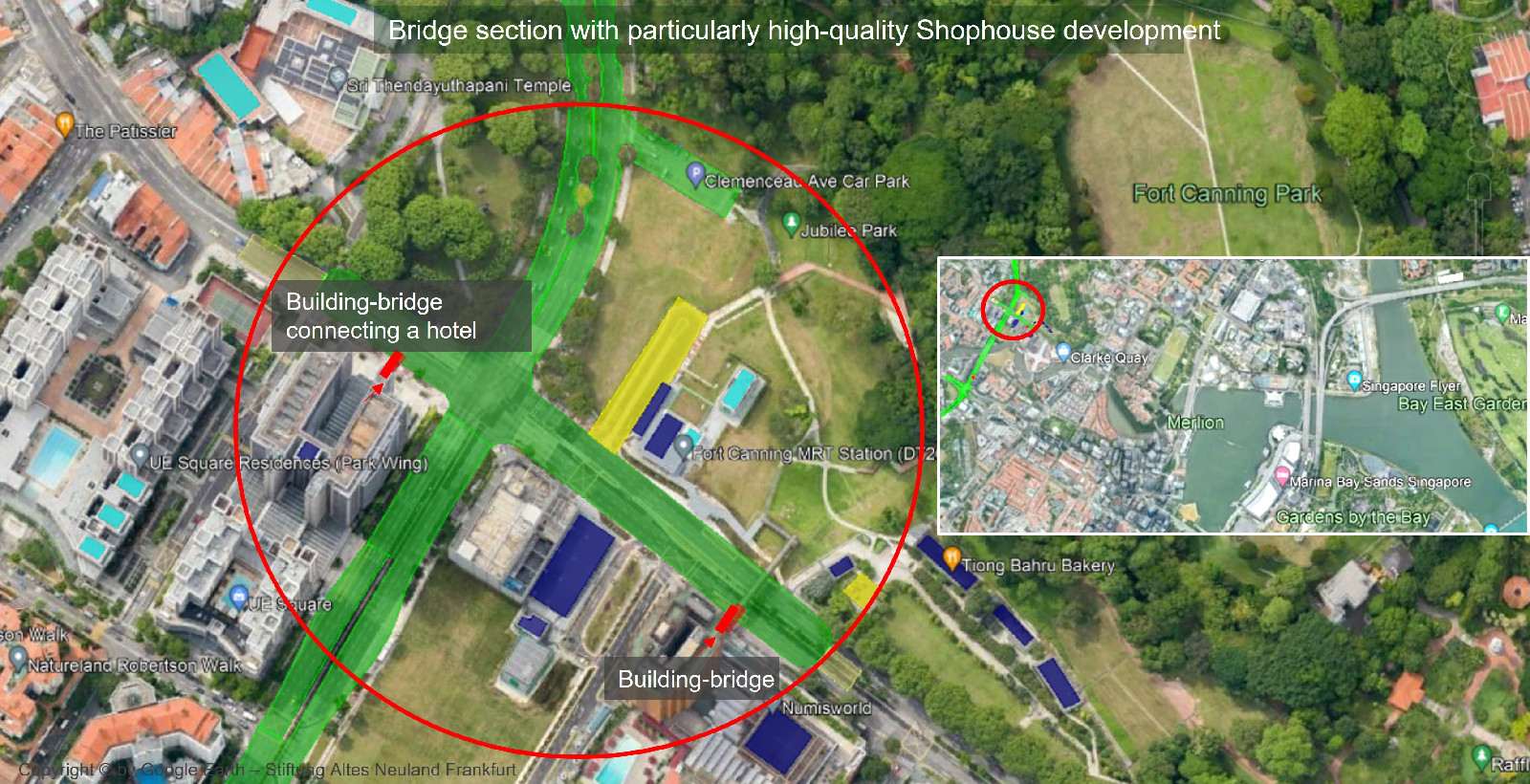
In addition, for all bridge sections it should be examined which buildings can be connected to the bridge corpus via so-called "building-bridges": For hotels, shopping malls, congress centres, etc., such a connection is of extremely high value, as it significantly increases their accessibility.
Also very popular are traditional "Black and White Houses" in Singapore - which fetch prices of up to 40,000 euros per square metre.
The houses date back to the colonial era and are a fascinating architectural mixture of British colonial style and local construction. They are mostly designed as single-family houses, but the design as a multi-family house is also possible.
Because they are traditionally free-standing buildings, Black and White Houses fit particularly well in places on Singapore's innovation bridges where terraced houses or high-rise buildings are structurally impossible.


The construction method of the Black and White Houses is adapted to the climate: Integrating learnings from their construction into new architecture can help to reduce the energy-intensive power-consumption for air-conditions
The houses have window fronts that let in a lot of light, but are not so high that the midday sun could penetrate the rooms if the angle of incidence is steep. Most houses have verandas, sort of as an extension of the interior rooms, so that one can also sit outside in the "living room".
The buildings are kept light inside and outside, and traditionally have beautiful shutters or numerous awnings.






The ideal area for Black and White Houses: on the Singapore Innovation Bridges near Alexandra Park
Alexandra Park is home to one of the largest clusters of Black and White Houses. Not only can a housing estate of Black and White Houses be built on the bridges next to it, but it also revitalises the area, as with all areas through which the bridges run: On them, in addition to residential buildings, there are restaurants, playgrounds, shops, kindergardens, and more – by having the Innovation Bridges in the neighbourhood, everything is suddenly within walking distance for the residents of Alexandra Park.

Bridge sections with conventional Shophouses or even Black and White Houses do not, however, exploit the maximum possible living space with their tendency towards low-rise development
Even though such streets are very charming and people usually love smaller, more manageable units, the precious bridge land that is created on the surfaces of the Singapore Innovation Bridges must still be utilized for as much building space as possible.
In some places on the Singapore Innovation Bridges, such areas of low-rise development may of course be created, especially where there are existing buildings very close to the bridges that would be affected by taller buildings on the bridges.

There are also three- to four-storey traditional buildings, which sometimes even have a special roof structure: Buildings of this type are ideally suited for large parts of the green Innovation Bridges in Singapore
Multi-storey Shophouses combine the charm of heritage properties with the advantage of larger building spaces. They are quite common in both Singapore and Malaysia, although they are in the minority. Since Shophouses are mostly narrow, but have a lot of depth to the rear, enough charming building space can be created with the help of multi-storey buildings without having to build entire high-rise buildings on the bridges.


(5) Singapore aims to reduce private transport: Singapore already has an excellent public transport network consisting of MRT and buses - the green innovation bridges only run in two places like the MRT, otherwise they mostly access other areas of the city

The existing transport network in Singapore can be supplemented with autonomous vehicles on the Singapore Innovation Bridges, for which e.g. WOHA Architects and the Singapore Ministry of Transport have already designed visions
Autonomous buses or trams will travel to specific bridge stations and transport several people at a time; individual vehicles, on the other hand, can be summoned via app to take people individually to drop-off points on and to places between Metro-stations, directly connecting significantly more points in the city than before.
This is similar to what is envisaged in the vision of the Singapore Ministry of Transport: Currently, the number of registered vehicles is limited to prevent the roads from becoming too crowded. However, the need for individually drivable routes will remain and the desire for door-to-door transport is likely to increase due to climate change.




Autonomously driving traffic drastically reduces the number of vehicles and is accordingly also the declared goal in Singapore - but it is difficult to integrate autonomously driving vehicles into the individual traffic that exists today
Autonomously driving traffic will only develop its full functionality and efficiency if there are no more "disruptive" individually self-acting road users. In order to create proprietary routes for an autonomously driving system, either today's normal self-driving traffic can be moved below ground level and the autonomously driving vehicles drive on the freed-up ground-level space; or normal traffic remains where it is and proprietary routes for autonomously driving traffic are created on a second level above. The bridges offer the latter solution option and are faster to build than deep laying entire road systems. On the bridges, autonomously driving "individual traffic" can be created without problems, and after going through learning effects, Singapore can start to transfer the system to its roads, later.

As an intermediate stage between "autonomously driving traffic only on the bridges" and "autonomously driving traffic on all levels", one solution could be that each traffic system gets its own lane next to other road users - however, the risk of disruptive "encroachments" remains


Successively converting existing traffic systems into autonomously driving traffic systems is virtually impossible, as the interaction between individually acting road users and artificial intelligence involves too many imponderables. If, however, separate lanes are created for autonomously driving vehicles, and if these lanes are possibly protected by guardrails, then coexistence in traffic is conceivable.
The Centre of Excellence for Testing & Research of Autonomous Vehicles in Singapore has been building up expertise in the testing and development of autonomous driving for years: Accordingly, there are already several autonomous driving vehicles in Singapore.


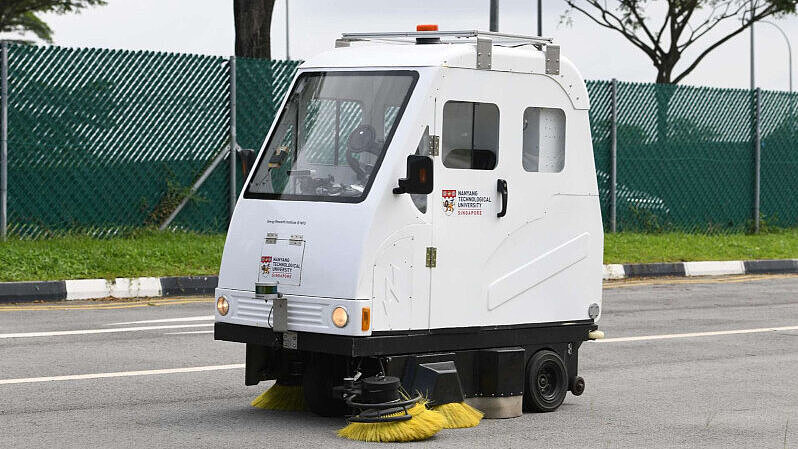
Currently, the design of autonomous driving vehicles in Singapore is not as modern and visionary as WOHA architects' visualizations, but rather they share the boring look with almost all autonomous driving vehicles worldwide.
On the green Innovation Bridges in Singapore, all models can be shown to advantage: ultra-modern cars that could have come from a science fiction movie as well as classic cars. Many people in Singapore love and appreciate oldtimer cars - for example, they are among the most popular wedding cars to rent for that special occasion.



Singapore appreciates traditional cultural assets: More trams like the time-honored Singapore Trolley Tram can run on Singapore‘s Innovation Bridges
As on the Frankfurt Bridges, vehicles in lightweight construction can travel on the green Innovation Bridges in Singapore: A wide variety of vintage buses and trains can be built modularly, so that each vehicle does not have to be completely redeveloped, but can be equipped with a different body but the same "inner workings". Together with the ultra-modern vehicles, a diversified fleet is created in which there is something suitable for every passenger. Especially in the case of the cars, this can make up for the fact that in the future, Car-Sharing will no longer allow you to select or equip your own car according to your individual taste, as you do nowadays purchasing it.

If normal traffic is one day replaced by autonomously driving traffic and the number of vehicles drops massively, the number of lanes can probably be reduced on many wide roads.
The space freed up under the bridges can be used for cyclists or walkers, but also (if it's wide enough) to build shops, nurseries, loft-style apartments and the like.



(6) Singapore has a strong awareness of sustainability and wants to reduce plastic waste - especially in the growing take-away sector
Due to its proximity to the equator and its high degree of ground sealing, Singapore suffers particularly from global warming. Accordingly, the willingness to use all possibilities to become CO2 neutral is high.
A particularly insidious form of CO2 pollution is caused by microplastics, which mostly enter nature through plastic waste: plankton contaminated with microplastics can bind less carbon dioxide from the atmosphere. As a result, the function of the oceans as a global carbon dioxide sink is reduced.
On the green Innovation Bridges, Singapore can establish a take-away system with containers made of glass and enamelled stainless steel, similar to the system on the Frankfurt Innovation Bridges.


When it comes to takeaway food packaging, there are two sustainable alternatives without any microplastics: enamelled thin stainless steel and more break-resistant, relatively thin - and therefore slightly lighter - glass
Compared to disposable packaging, stainless steel and glass packagings are sustainable: with stainless steel, one can assume a shelf life of several decades, with robust glass quite some years. In the former German Democratic Republic (Eastern Germany), extremely durable, thin glasses were produced that are still doing their job in some restaurants today, more than 40 years later.
The technology was developed in the 70s of the last century. But since glasses that do not break are not a profitable business model, production was discontinued after Germany‘s reunification and no further research was carried out.
Research into glass technology for smartphones has led to rapid improvements in break resistance of glass over the last two decades: a wide variety of tempering processes and laminated glass materials have been developed. The experience gained from these research fields should be used for the further development of take-away tableware and containers made of break-resistant glass.
Even though both materials, stainless steel and glass, are relatively energy-intensive in production, the energy expenditure is amortized relatively quickly through the long period of use. If the glass and steel table ware and containers are recycled, the energy balance is even better.
Transport-, cleaning- and other process-energy can always be expended during the day when photovoltaically generated electricity is abundant. They are cleaned with the aid of steam and UV radiation, i.e. with comparatively little water or detergent.
In addition, packaging made of lightweight shatterproof glass or thin enamelled stainless steel meets another important criterion: Even if it ends up somewhere in the environment, breaks or is disposed of incorrectly - it leaves no microplastics behind.

Another major source of risk for water contamination through the formation of microplastics: green roofs and facades
Green roofs and facades have only been available on a large scale worldwide for two decades. Accordingly, no comprehensive studies are yet available on how the materials used for waterproofing and fastening as well as irrigation behave after 30, 40 or more years. Although it is an advantage that the mostly used synthesized plastics are hardly exposed to UV light or wind, they are not completely free from environmental stress: Especially the irrigation of plants and the associated minerals and (often acidic) substances dissolved in the water represent a plastic burden whose effect on the variety of plastics used for green roofs and facades has not yet been researched.
Singapore has been pushing the greening of its roofs and façades for many years, and thus runs the greater risk of having a flood of microplastics from corroding plastics or plastics that dissolve due to mechanical influences in rainwater runoff in the future: This is because roofs, like facades, are not renewed in short cycles, but often fulfil their function for decades before they have to be renovated.
The Singapore Innovation Bridges are therefore to be greened using inert materials and subsurface irrigation, following the example of the Frankfurt Innovation Bridges, and serve as a huge research area for low-plastic greening systems.

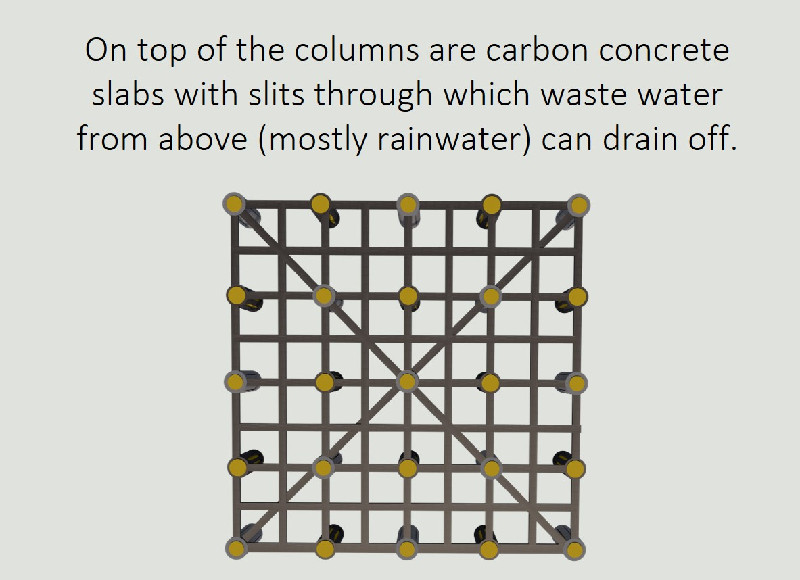
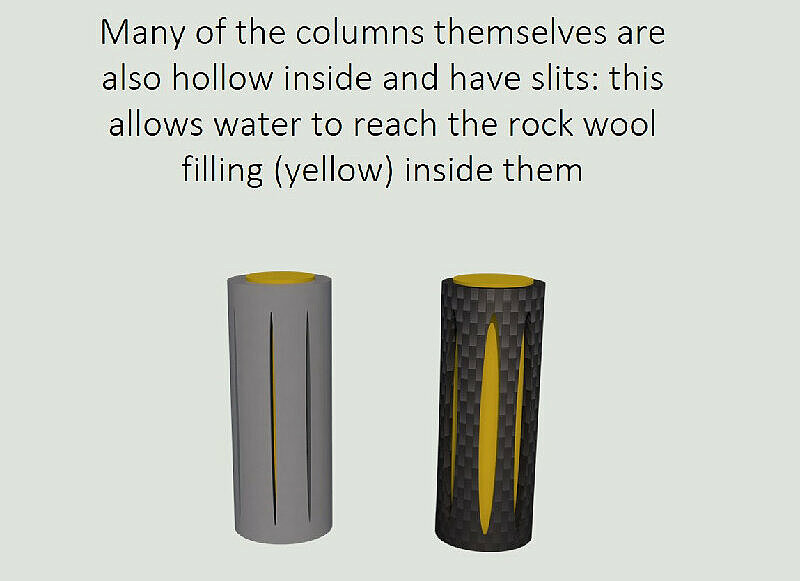
Conclusion: With the bridges over its roads, Singapore has the opportunity to gain almost 6 million square meters of high-quality land in the middle of its populated areas: At the same time, it can solve energy, water, transport and housing problems on a second level with the help of the country‘s innovative strength and willingness to implement
Singapore is already on its way to becoming the "sustainable city of the future": Technological expertise and political will to implement have led to modern and sustainable solutions. But the country still has numerous challenges to overcome, for which one thing in particular is lacking: space.
With the Singapore Innovation Bridges, additional land area is created, not in the sea, but running through the middle of populated areas. With the bridges, Singapore has the opportunity to implement all the innovations that cannot be implemented immediately in existing living areas but require long development cycles, such as an electricity grid with a control system for volatile photovoltaic energy and the like.
As the bridge surfaces should be greened throughout whereever there is no house, pedestrians walking or vehicles driving on them, Singapore can apply its sound and broad expertise of facade and roof greening, researching and applying microplastic-free fastening and irrigation elements on this huge area, following the example of the Frankfurt Innovation Bridges.
At the same time, Singapore has the opportunity to expand a somewhat small-scale, varied, two- to five-storey traditional building stock on these green innovation bridges to complement its ultra-modern architecture, expecially in places on the bridges that do not permit six- or seven-storey buildings. Singapore has the means to have such traditional residential areas competently built from sustainable raw materials by bringing in not only its own artisans but also skilled craftsmen from the Malay-Chinese or even Indian cultural environments.
With the Innovation Bridges, a supplement to the existing city is created - and tranferring learnings from the bridges, the existing living areas of the city can also be further modernised and optimised.